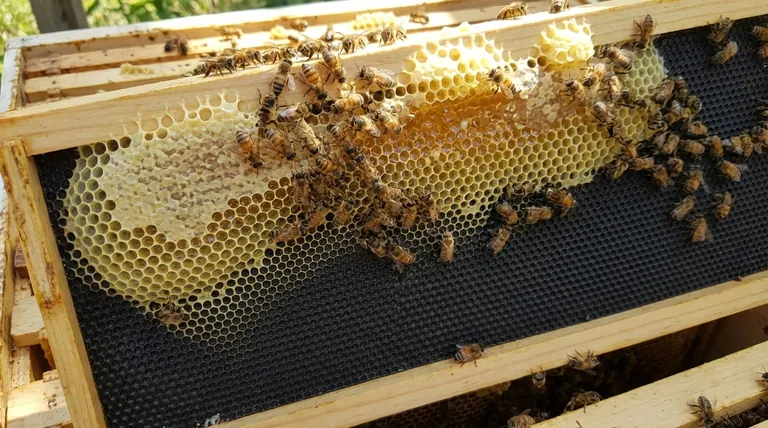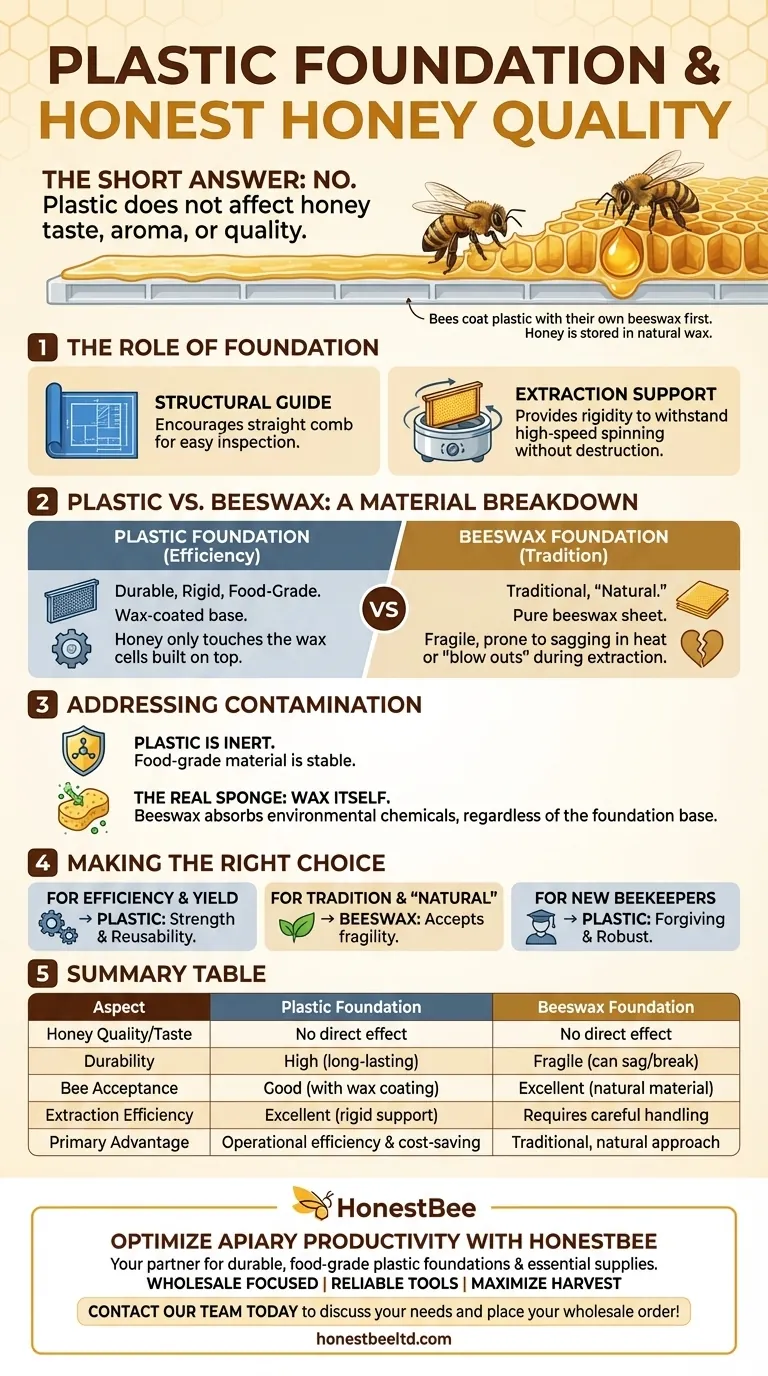From a purely chemical and sensory standpoint, the answer is no. Food-grade plastic foundation does not directly affect the taste, aroma, or overall quality of honey. The bees first coat the plastic with their own beeswax before building the comb and storing honey, meaning the honey itself is held entirely within natural wax cells.
The choice between plastic and wax foundation is not about honey quality, which remains unaffected. Instead, it is a practical decision about hive management, durability, and operational efficiency, with each option presenting distinct advantages and trade-offs.

Why Foundation is Used in Modern Beekeeping
Foundation serves as a structural guide for honey bees. Understanding its purpose is key to evaluating the materials used to make it.
The Principle of Structural Support
Bees are master architects, but they require a blueprint. Foundation, whether plastic or wax, is a sheet embossed with the hexagonal pattern of honeycomb cells that encourages bees to build straight, orderly comb within a removable frame.
Without this guide, bees often build "cross comb" that connects multiple frames, making hive inspections nearly impossible without destroying the comb and potentially harming the queen.
Critical for Honey Extraction
The primary function of foundation is to provide rigidity. When a frame full of honey is placed in a centrifugal extractor, the force required to spin out the honey would tear natural, unsupported comb to pieces.
A solid foundation, particularly plastic, provides the necessary backbone to keep the comb intact, allowing the frame to be emptied and reused by the bees immediately.
Plastic vs. Beeswax: A Material Breakdown
The debate centers on two materials that achieve the same goal through different means. Your choice impacts your workflow far more than it impacts the honey.
How Plastic Foundation Works
Plastic foundation is a durable, rigid sheet of food-grade plastic molded with the cell base pattern. Most commercial plastic foundations come pre-coated with a thin layer of beeswax to encourage the bees to accept it and begin drawing comb.
The bees build out the wax cell walls from this base. The honey is only ever in contact with the beeswax walls and cap they create, not the plastic sheet behind it.
How Beeswax Foundation Works
This is the traditional method. A sheet of pure beeswax is pressed to create the same hexagonal pattern. Bees readily accept and build upon it, as it is a material they produce themselves.
While seen as more "natural," beeswax foundation is far more fragile than plastic, especially in hot weather or during extraction.
Understanding the Trade-offs
Neither option is universally superior; they serve different priorities. Acknowledging the trade-offs is crucial for making an informed decision.
The Case for Plastic: Durability and Efficiency
Plastic foundation's greatest strengths are its durability and longevity. It can withstand rough handling, resist damage from pests like wax moths, and endure the high-speed forces of extraction without breaking.
For beekeepers focused on honey production, this means faster, more efficient harvesting and frames that can be reused for many years, representing a long-term cost saving.
The Case for Beeswax: Tradition and Acceptance
Many beekeepers prefer wax foundation because it feels more aligned with the natural processes of the hive. Some also observe that bees can be quicker to draw out comb on a full wax sheet compared to a thinly coated plastic one.
The primary downside is fragility. Beeswax foundation can sag in high heat, and new comb can easily "blow out" in an extractor if not handled with extreme care.
The Contamination Concern
The fear that plastic might "leach" into honey is understandable but unfounded with modern, food-grade materials. The plastic used is inert and stable.
Ironically, the greater, though still minimal, risk of chemical contamination in a hive comes from the wax itself. Beeswax can act like a sponge for environmental pesticides and agricultural chemicals brought back by foraging bees. This risk exists regardless of whether the wax is built on a plastic base or a wax one.
Making the Right Choice for Your Goal
Your decision should be based on your specific beekeeping philosophy and operational needs.
- If your primary focus is efficiency and honey yield: Plastic foundation is the superior choice for its strength in extraction and long-term reusability.
- If your primary focus is a traditional or "natural" approach: Beeswax foundation or foundationless frames align better with this philosophy, but you must accept the need for more careful handling.
- If you are a new beekeeper: Plastic foundation is often the recommended starting point, as its robustness is more forgiving of beginner mistakes during hive inspections and harvesting.
Ultimately, high-quality honey comes from healthy bees with access to clean forage, and your choice of foundation is a practical tool to support that core mission.
Summary Table:
| Aspect | Plastic Foundation | Beeswax Foundation |
|---|---|---|
| Honey Quality/Taste | No direct effect | No direct effect |
| Durability | High (long-lasting) | Fragile (can sag/break) |
| Bee Acceptance | Good (with wax coating) | Excellent (natural material) |
| Extraction Efficiency | Excellent (rigid support) | Requires careful handling |
| Primary Advantage | Operational efficiency & cost-saving | Traditional, natural approach |
Optimize your apiary's productivity and honey yield with the right equipment. HONESTBEE supplies durable, food-grade plastic foundations and other essential beekeeping supplies to commercial apiaries and distributors. Our wholesale-focused operations ensure you get reliable, efficient tools that support healthy hives and maximize your harvest. Contact our team today to discuss your needs and place your wholesale order!
Visual Guide

Related Products
- Food Grade Plastic bee Foundation for Bee Frames
- Beeswax Foundation Sheets Beehive Foundation for Wholesale
- Manual Beeswax Comb Foundation Machine Wax Foundation Mill Embossing Machine
- Professional Galvanized Hive Strap with Secure Locking Buckle for Beekeeping
- JZBZ Type Wide Base Plastic Queen Cell Cups for Base Mounting and Queen Rearing
People Also Ask
- How to get bees to use plastic foundation? Master the Wax Coating and Resource Strategy
- How do you get bees to draw out plastic foundation? Master the Art of Comb Building
- How to get bees to draw out plastic foundation? Boost Comb Building with Proven Tactics
- Why is it beneficial to coat plastic foundation with beeswax? Boost Hive Acceptance & Comb Building
- Why do commercial beekeepers prefer plastic foundation? Durable, Reusable, and Cost-Effective



















